Spatial and Temporal Variation in Local Stormwater Infrastructure Use and Stormwater Management Paradigms over the 20th Century
Abstract
:1. Introduction
- (1)
- How does current infrastructure use and past infrastructure transitions vary across 3 cities with similar biophysical and climatic contexts but different development stages and histories?
- (2)
- How did stormwater and flood management paradigms change from early urbanization to current day in a single city?
2. Materials and Methods
2.1. Study Sites
2.2. Reconstructing Infrastructure Use
2.3. Defining Management Paradigms: Media Content Analysis
3. Results
3.1. Research Question 1: Infrastructure Use across Cities
3.2. Research Question 2: Stormwater Management Paradigms in Salt Lake City
4. Discussion
4.1. Moving to a More Nuanced Understanding of Urban Water Management Trajectories
4.2. Paradigm Shifts in Stormwater Management
5. Conclusions
Acknowledgments
Conflicts of Interest
References
- Arnold, C.L.; Gibbons, C.J. Impervious surface coverage—The emergence of a key environmental indicator. J. Am. Plan. Assoc. 1996, 62, 243–258. [Google Scholar] [CrossRef]
- Elmore, A.J.; Kaushal, S.S. Disappearing headwaters: Patterns of stream burial due to urbanization. Front. Ecol. Environ. 2008, 6, 308–312. [Google Scholar] [CrossRef]
- Steele, M.K.; Heffernan, J.B.; Bettez, N.; Cavender-Bares, J.; Groffman, P.M.; Grove, J.M.; Hall, S.; Hobbie, S.E.; Larson, K.; Morse, J.L.; et al. Convergent surface water distributions in U.S. cities. Ecosystems 2014, 17, 685–697. [Google Scholar] [CrossRef]
- Hopkins, K.G.; Bain, D.J.; Copeland, E.M. Reconstruction of a century of landscape modification and hydrologic change in a small urban watershed in Pittsburgh, PA. Landsc. Ecol. 2014, 29, 413–424. [Google Scholar] [CrossRef]
- Hale, R.L.; Turnbull, L.; Earl, S.R.; Childers, D.L.; Grimm, N.B. Stormwater infrastructure controls runoff and dissolved material export from arid urban watersheds. Ecosystems 2015, 18, 62–75. [Google Scholar] [CrossRef]
- Johnson, T.A.N.; Kaushal, S.S.; Mayer, P.M.; Grese, M.M. Effects of stormwater management and stream restoration on watershed nitrogen retention. Biogeochemistry 2014, 121, 81–106. [Google Scholar] [CrossRef]
- Hatt, B.E.; Fletcher, T.D.; Walsh, C.J.; Taylor, S.L. The influence of urban density and drainage infrastructure on the concentrations and loads of pollutants in small streams. Environ. Manag. 2004, 34, 112–124. [Google Scholar] [CrossRef] [PubMed]
- Larson, E.K.; Grimm, N.B. Small-scale and extensive hydrogeomorphic modification and water redistribution in a desert city and implications for regional nitrogen removal. Urban Ecosyst. 2012, 15, 71–85. [Google Scholar] [CrossRef]
- Meierdiercks, K.L.; Smith, J.A.; Baeck, M.L.; Miller, A.J. Analyses of urban drainage network structure and its impact on hydrologic response. J. Am. Water Resour. Assoc. 2010, 46, 932–943. [Google Scholar] [CrossRef]
- Paul, M.J.; Meyer, J.L. Streams in the urban landscape. Annu. Rev. Ecol. Syst. 2001, 32, 333–365. [Google Scholar] [CrossRef]
- Ashley, R.M.; Balmforth, D.J.; Saul, A.J.; Blanskby, J.D. Flooding in the future-predicting climate change, risks and responses in urban areas. Water Sci. Technol. 2005, 52, 265–273. [Google Scholar] [PubMed]
- Roy, A.; Wenger, S.; Fletcher, T.; Walsh, C.; Ladson, A.; Shuster, W.; Thurston, H.; Brown, R. Impediments and solutions to sustainable, watershed-scale urban stormwater management: Lessons from Australia and the United States. Environ. Manag. 2008, 42, 344–359. [Google Scholar] [CrossRef] [PubMed]
- Hopkins, K.G.; Morse, N.B.; Bain, D.J.; Bettez, N.D.; Grimm, N.B.; Morse, J.L.; Palta, M.M. Type and timing of stream flow changes in urbanizing watersheds in the Eastern U.S. Elem. Sci. Anthr. 2015, 3, 56. [Google Scholar] [CrossRef]
- Denault, C.; Millar, R.; Lence, B. Assessment of possible impacts of climate change in an urban catchment. J. Am. Water Resour. Assoc. 2006, 42, 685–697. [Google Scholar] [CrossRef]
- Forsee, W.; Ahmad, S. Evaluating Urban Storm-Water Infrastructure Design in Response to Projected Climate Change. J. Hydrol. Eng. 2011, 16, 865–873. [Google Scholar] [CrossRef]
- Burian, S.J.; Nix, S.J.; Pitt, R.E.; Durrans, S.R. Urban Wastewater Management in the United States: Past, Present, and Future. J. Urban Technol. 2000, 7, 33–62. [Google Scholar] [CrossRef]
- Chocat, B.; Krebs, P.; Marsalek, J.; Rauch, W.; Schilling, W. Urban drainage redefined: From stormwater removal to integrated management. Water Sci. Technol. 2001, 43, 61–68. [Google Scholar] [PubMed]
- Delleur, J.W. The Evolution of Urban Hydrology: Past, Present, and Future. J. Hydraul. Eng. 2003, 129, 563–573. [Google Scholar] [CrossRef]
- Brown, R.R.; Farrelly, M.A.; Loorbach, D.A. Actors working the institutions in sustainability transitions: The case of Melbourne’s stormwater management. Glob. Environ. Chang. 2013, 23, 701–718. [Google Scholar] [CrossRef]
- Kaushal, S.S.; McDowell, W.H.; Wollheim, W.M.; Johnson, T.A.N.; Mayer, P.M.; Belt, K.T.; Pennino, M.J. Urban Evolution: The Role of water. Water 2015, 7, 4063–4087. [Google Scholar] [CrossRef]
- Wong, T.H.F.; Brown, R.R. The water sensitive city: Principles for practice. Water Sci. Technol. 2009, 60, 673–682. [Google Scholar] [CrossRef] [PubMed]
- Groffman, P.M.; Cavender-Bares, J.; Bettez, N.D.; Grove, J.M.; Hall, S.J.; Heffernan, J.B.; Hobbie, S.E.; Larson, K.L.; Morse, J.L.; Neill, C.; et al. Ecological homogenization of urban USA. Front. Ecol. Environ. 2014, 12, 74–81. [Google Scholar] [CrossRef]
- Kennedy, C.; Cuddihy, J.; Engel-Yan, J. The changing metabolism of cities. J. Ind. Ecol. 2007, 11, 43–59. [Google Scholar] [CrossRef]
- York, A.M.; Shrestha, M.; Boone, C.G.; Zhang, S.; Harrington, J.A.; Prebyl, T.J.; Swann, A.; Agar, M.; Antolin, M.F.; Nolen, B.; et al. Land fragmentation under rapid urbanization: A cross-site analysis of Southwestern cities. Urban Ecosyst. 2011, 14, 429–455. [Google Scholar] [CrossRef]
- Parr, T.B.; Smucker, N.J.; Neale, M.W.; Bentsen, C.N. Potential roles of past, present, and future urbanization characteristics in producing varied stream responses. Freshw. Sci. 2016, 35, 436–443. [Google Scholar] [CrossRef]
- Brown, L.R.; Cuffney, T.F.; Coles, J.F.; Fitzpatrick, F.; McMahon, G.; Steuer, J.; Bell, A.H.; May, J.T. Urban streams across the USA: Lessons learned from studies in 9 metropolitan areas. J. N. Am. Benthol. Soc. 2009, 28, 1051–1069. [Google Scholar] [CrossRef]
- US Census Bureau 2010 Census Urban and Rural Classification and Urban Area Criteria. Available online: https://www.census.gov/geo/reference/ua/urban-rural-2010.html (accessed on 15 July 2016).
- Governor’s Office of Planning and Budget, 2012 Baseline Projections. Available online: http://gomb.utah.gov/wp-content/uploads/sites/7/2013/08/Population-by-Age-and-Area.xlsx (accessed on 15 July 2016).
- Armstrong, A. Organizational Adaptation in Local Stormwater Governance. Ph.D. Thesis, Utah State University, Logan, UT, USA, 2015. [Google Scholar]
- Xian, G.; Homer, C.; Dewitz, J.; Fry, J.; Hossain, N.; Wickham, J. Change of impervious surface area between 2001 and 2006 in the conterminous United States. Photogramm. Eng. Remote Sens. 2011, 77, 758–762. [Google Scholar]
- Homer, C.G.; Dewitz, J.A.; Yang, L.; Jin, S.; Danielson, P.; Xian, G.; Coulston, J.; Herold, N.D.; Wickham, J.D.; Megown, K. Completion of the 2011 National Land Cover Database for the conterminous United States—Representing a decade of land cover change information. Photogramm. Eng. Remote Sens. 2015, 81, 345–354. [Google Scholar]
- Crawley, C.E. Localized Debates of Agricultural Biotechnology in Community Newspapers: A Quantitative Content Analysis of Media Frames and Sources. Sci. Commun. 2007, 28, 314–346. [Google Scholar] [CrossRef]
- Utah Digital Newspapers-Home. Available online: http://digitalnewspapers.org/ (accessed on 15 July 2016).
- Unusual Rainfall Hits City. Available online: https://newspapers.lib.utah.edu/pdfjs/web/viewer.html?file=/udnfiles/fe/c3/fec3e97622dc6aee592e2f956b652926036aeb9e.pdf (accessed on 20 July 2016).
- Schueler, T.R.; Fraley-McNeal, L.; Cappiella, K. Is Impervious Cover Still Important? Review of Recent Research. J. Hydrol. Eng. 2009, 14, 309–315. [Google Scholar] [CrossRef]
- Shuster, W.D.; Bonta, J.; Thurston, H.; Warnemuende, E.; Smith, D.R. Impacts of impervious surface on watershed hydrology: A review. Urban Water J. 2005, 2, 263–275. [Google Scholar] [CrossRef]
- Walsh, C.J.; Roy, A.H.; Feminella, J.W.; Cottingham, P.D.; Groffman, P.M.; Morgan, R.P. The urban stream syndrome: Current knowledge and the search for a cure. J. N. Am. Benthol. Soc. 2005, 24, 706–723. [Google Scholar] [CrossRef]
- Knouft, J.H.; Chu, M.L. Using watershed-scale hydrological models to predict the impacts of increasing urbanization on freshwater fish assemblages. Ecohydrology 2015, 8, 273–285. [Google Scholar] [CrossRef]
- Nelson, K.C.; Palmer, M.A.; Pizzuto, J.E.; Moglen, G.E.; Angermeier, P.L.; Hilderbrand, R.H.; Dettinger, M.; Hayhoe, K. Forecasting the combined effects of urbanization and climate change on stream ecosystems: From impacts to management options. J. Appl. Ecol. 2009, 46, 154–163. [Google Scholar] [CrossRef] [PubMed]
- Brown, R.; Farrelly, M. Challenges ahead: Social and institutional factors influencing sustainable urban stormwater management in Australia. Water Sci. Technol. 2009, 59, 653–660. [Google Scholar] [CrossRef] [PubMed]
- Keeley, M.; Koburger, A.; Dolowitz, D.P.; Medearis, D.; Nickel, D.; Shuster, W. Perspectives on the Use of Green Infrastructure for Stormwater Management in Cleveland and Milwaukee. Environ. Manag. 2013, 51, 1093–1108. [Google Scholar] [CrossRef] [PubMed]
- Findlay, D. Rainwater collection, water law, and climate change: A flood of problems waiting to happen. NC J. Law Technol. 2008, 10, 74. [Google Scholar]
- Cummings, K. Adapting to Water Scarcity: A Comparative Analysis of Water Harvesting Regulation in the Four Corner States. J. Environ. Law Litig. 2012, 27, 539. [Google Scholar]
- Decker, E.H.; Elliott, S.; Smith, F.; Blake, D.R.; Rowland, F.S. Energy and material flow through the urban ecosystem. Annu. Rev. Energy Environ. 2000, 25, 685–740. [Google Scholar] [CrossRef]
- Brown, R.R.; Keath, N.; Wong, T.H.F. Urban water management in cities: Historical, current and future regimes. Water Sci. Technol. J. Int. Assoc. Water Pollut. Res. 2009, 59, 847–855. [Google Scholar] [CrossRef] [PubMed]
- National Research Council (NRC). Urban Stormwater Management in the United States; National Academies Press: Washington, DC, USA, 2008. [Google Scholar]
- Ernstson, H.; van der Leeuw, S.E.; Redman, C.L.; Meffert, D.J.; Davis, G.; Alfsen, C.; Elmqvist, T. Urban Transitions: On Urban Resilience and Human-Dominated Ecosystems. Ambio 2010, 39, 531–545. [Google Scholar] [CrossRef] [PubMed]
- Durand, C.; Dagenais, M. Cleaning, Draining, and Sanitizing the City: Conceptions and Uses of Water in the Montreal Region. Can. Hist. Rev. 2006, 87, 621–651. [Google Scholar]
- City Prepares for Work on Storm Sewer. Available online: https://newspapers.lib.utah.edu/pdfjs/web/viewer.html?file=/udnfiles/a1/ed/a1ed3770fca69712be40d91873fd72132c537bd5.pdf (accessed on 20 July 2016).
- Driever, S.L.; Vaughn, D.M. Flood Hazard in Kansas City since 1880. Geogr. Rev. 1988, 78, 1–19. [Google Scholar] [CrossRef]
- Frantzeskaki, N.; Loorbach, D. Towards governing infrasystem transitions: Reinforcing lock-in or facilitating change? Technol. Forecast. Soc. Chang. 2010, 77, 1292–1301. [Google Scholar] [CrossRef]
- NCDC Storm Events Database-Data.gov. Available online: https://catalog.data.gov/dataset/ncdc-storm-events-database (accessed on 15 July 2016).
- Castonguay, S. The Production of Flood as Natural Catastrophe: Extreme Events and the Construction of Vulnerability in the Drainage Basin of the St. Francis River (Quebec), Mid-Nineteenth to Mid-Twentieth Century. Environ. Hist. 2007, 12, 820–844. [Google Scholar] [CrossRef]
- Brugger, J.; Crimmins, M. The art of adaptation: Living with climate change in the rural American Southwest. Glob. Environ. Chang. 2013, 23, 1830–1840. [Google Scholar] [CrossRef]
- Buckland, J.; Rahman, M. Community-based disaster management during the 1997 Red River Flood in Canada. Disasters 1999, 23, 174–191. [Google Scholar] [CrossRef] [PubMed]
- Hearne, R.R. Evolving water management institutions in the Red River basin. Environ. Manag. 2007, 40, 842–852. [Google Scholar] [CrossRef] [PubMed]
- Simonovic, S.P.; Carson, R.W. Flooding in the Red River Basin–Lessons from Post Flood Activities. Nat. Hazards 2003, 28, 345–365. [Google Scholar] [CrossRef]
- Baumgartner, F.R. Punctuated Equilibrium Theory and Environmental Policy. In Punctuated Equilibrium and the Dynamics of U.S. Environmental Policy; Yale University Press: New Haven, CT, USA, 2006; pp. 24–46. [Google Scholar]
- Meijerink, S. Understanding policy stability and change the interplay of advocacy coalitions and epistemic communities, windows of opportunity, and Dutch coastal flooding policy 1945–2003 1. J. Eur. Public Policy 2005, 12, 1060–1077. [Google Scholar] [CrossRef]
- Sabatier, P. An Advocacy Coalition Framework of Policy Change and the Role of Policy-Oriented Learning Therein. In Public Policy Theories, Models, and Concepts; Prentice Hall: Englewood Cliffs, NJ, USA, 1995; pp. 339–379. [Google Scholar]
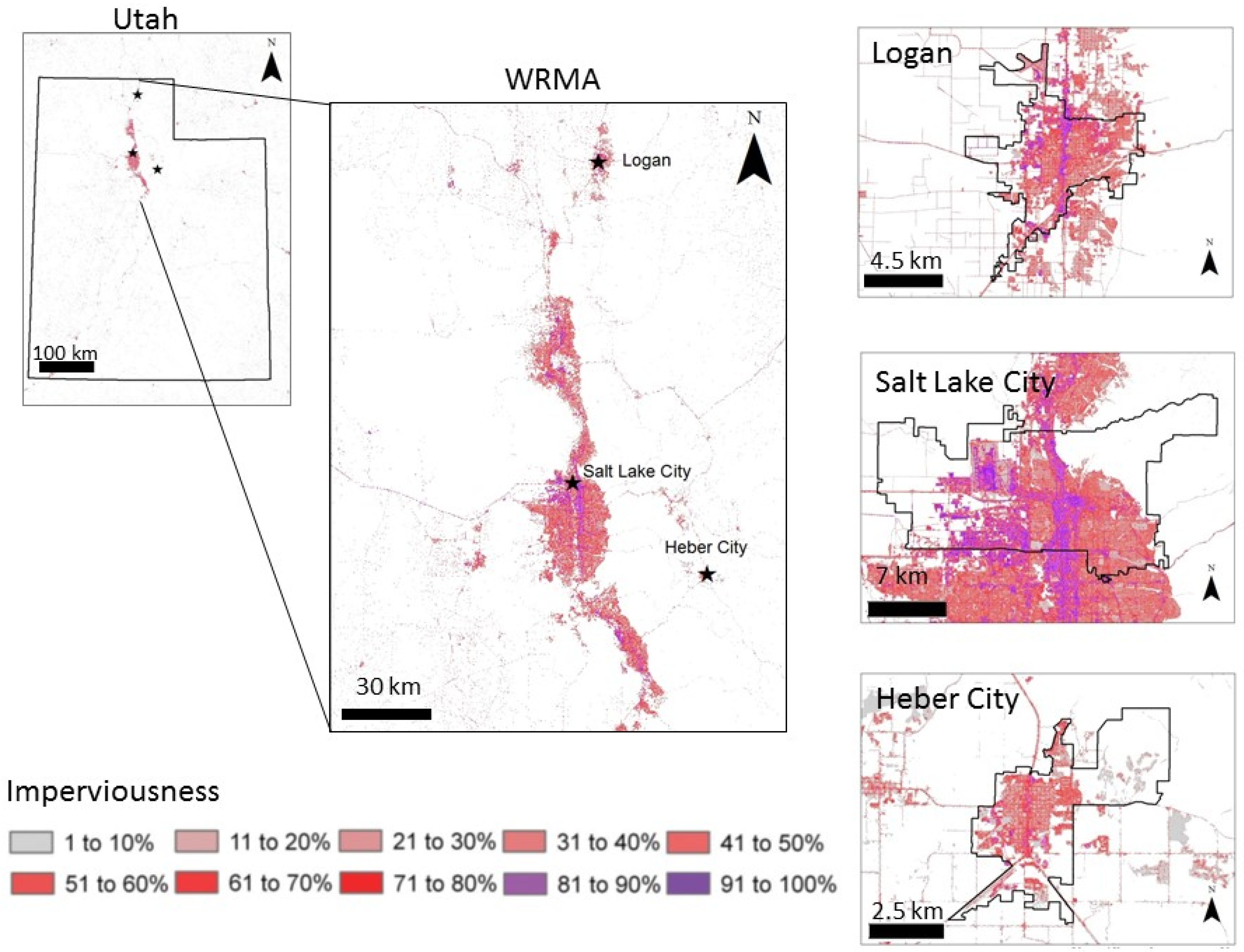
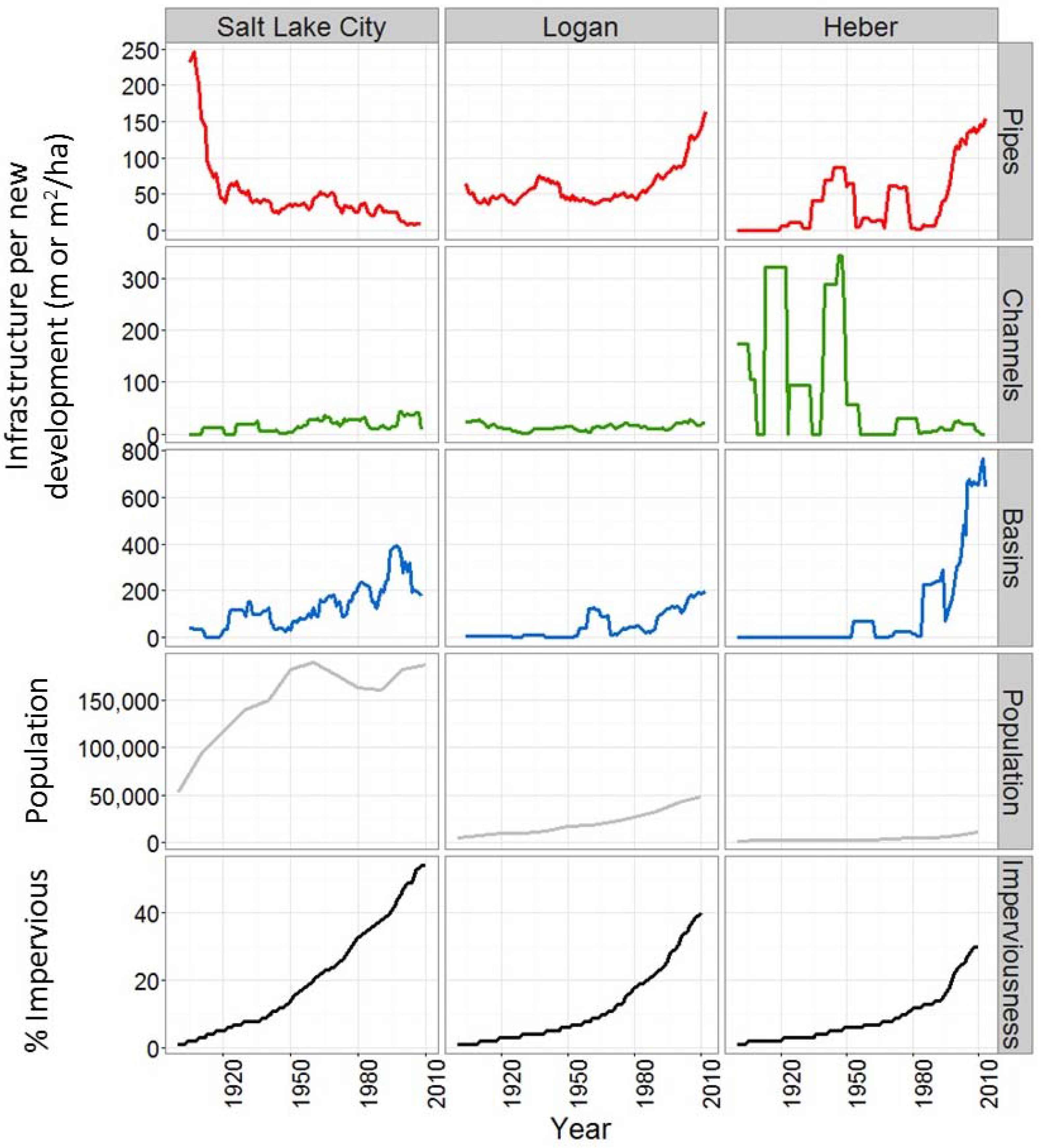
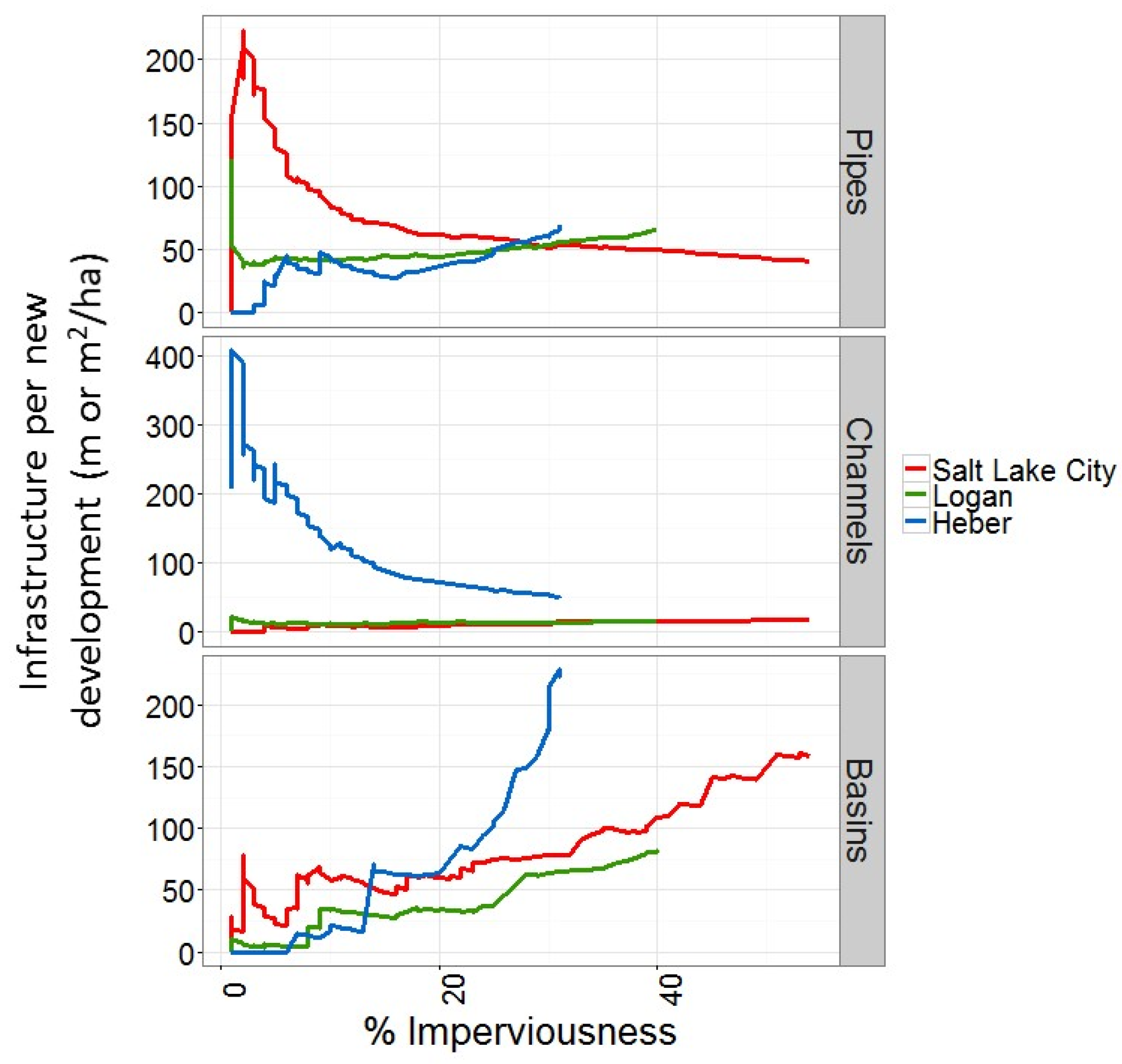
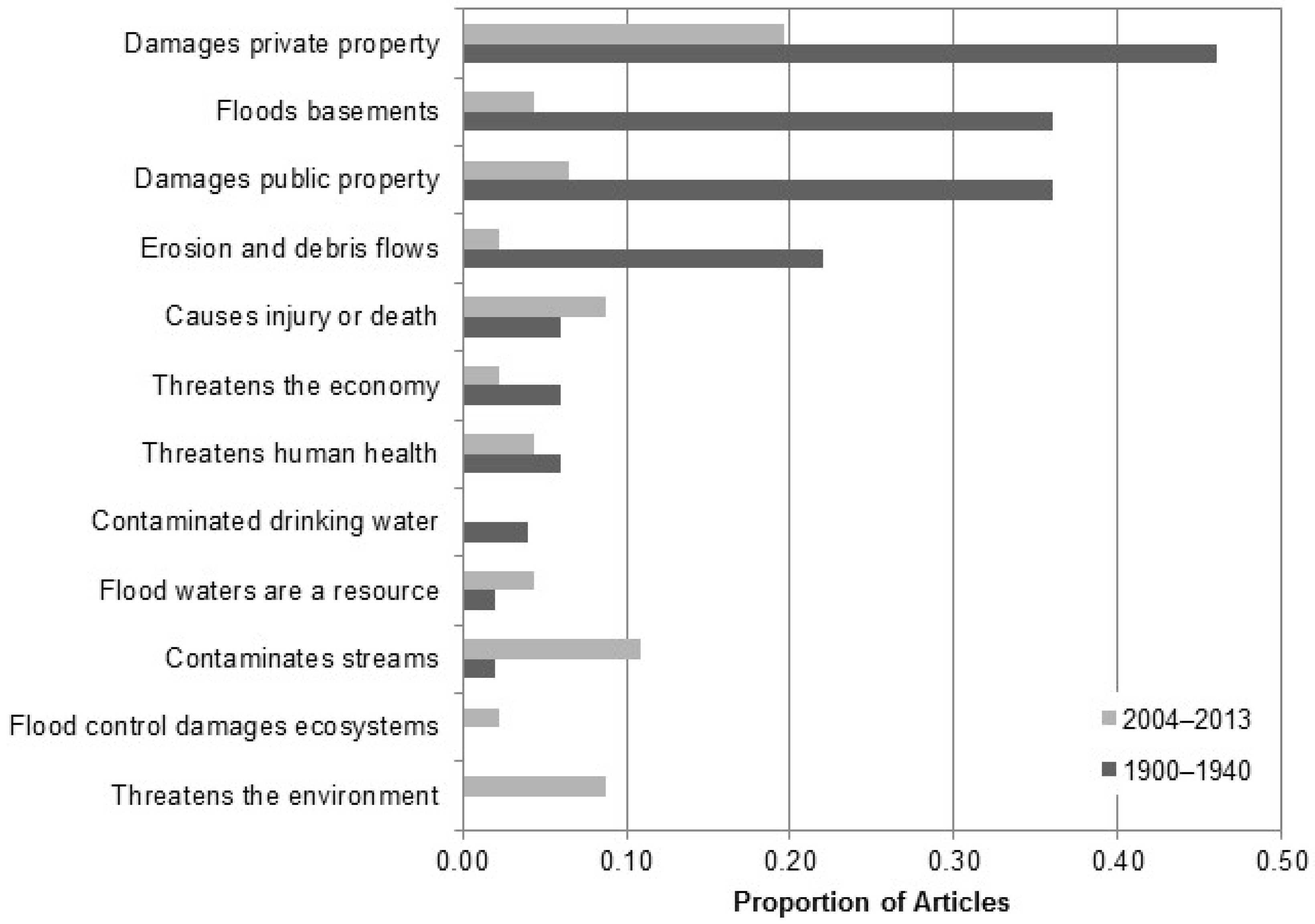
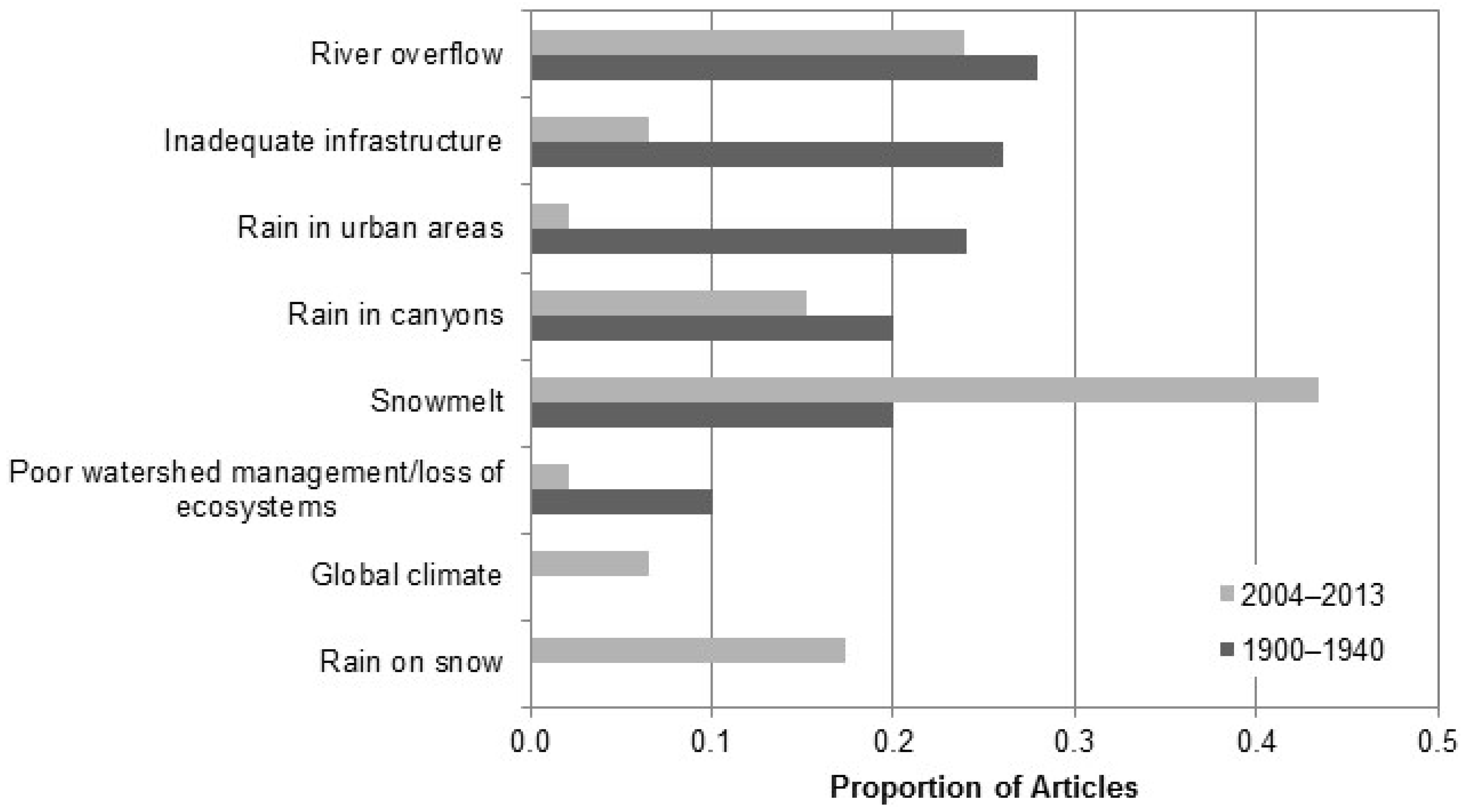

| Characteristics | Salt Lake City | Logan | Heber City |
|---|---|---|---|
| Population (2013) | 191,180 | 48,913 | 12,911 |
| First settled | 1847 | 1859 | 1859 |
| Average Annual Population Growth | ˗ | ˗ | ˗ |
| 1900 to 1950 | 4.80% | 4.18% | 1.40% |
| 1950 to 2000 | 0.00% | 3.08% | 2.96% |
| 2000 to 2014 | 0.14% | 0.14% | 1.43% |
| Decade with fastest growth rate | 1900 (73%) | 1950 (42%) | 2000 (56%) |
| City stormwater management | Public Utilities | Public Works | City Engineering |
| Impact fees for stormwater (per single family unit) | $374 | $306 | $0 |
| Impervious surface (%, 2011) | 54 | 40 | 31 |
© 2016 by the author; licensee MDPI, Basel, Switzerland. This article is an open access article distributed under the terms and conditions of the Creative Commons Attribution (CC-BY) license (http://creativecommons.org/licenses/by/4.0/).
Share and Cite
Hale, R.L. Spatial and Temporal Variation in Local Stormwater Infrastructure Use and Stormwater Management Paradigms over the 20th Century. Water 2016, 8, 310. https://doi.org/10.3390/w8070310
Hale RL. Spatial and Temporal Variation in Local Stormwater Infrastructure Use and Stormwater Management Paradigms over the 20th Century. Water. 2016; 8(7):310. https://doi.org/10.3390/w8070310
Chicago/Turabian StyleHale, Rebecca L. 2016. "Spatial and Temporal Variation in Local Stormwater Infrastructure Use and Stormwater Management Paradigms over the 20th Century" Water 8, no. 7: 310. https://doi.org/10.3390/w8070310
APA StyleHale, R. L. (2016). Spatial and Temporal Variation in Local Stormwater Infrastructure Use and Stormwater Management Paradigms over the 20th Century. Water, 8(7), 310. https://doi.org/10.3390/w8070310





